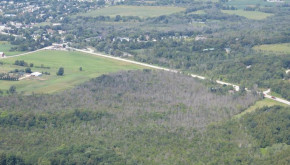
If you have any ash trees on your property, you’ve likely heard about the problems that emerald ash borer (EAB) brings. The EAB beetle is native to Asia and has killed millions of ash trees where it has been discovered, particularly in the US Midwest given it’s discovery in Detroit Michigan in 2002. As of today, the EAB beetle has been observed in 35 states in the US and five Canadian provinces.
In Minnesota we recently passed the ten-year “anniversary” of EAB’s first discovery in the state. Because of the tremendous impacts that EAB has had on ash trees and forests, a large volume of on-the-ground research has occurred over the past ten years.
The University of Minnesota Extension is in the process of updating its Ash Management Guidelines for Woodland Owners to reflect all of the new knowledge acquired about this invasive species. The Guidelines contain detailed information on ash trees and EAB and the native plant communities where ash trees grow. UMN Extension has produced and a list of potential replacement trees for ash that reflects this work.
Here are four options for woodland owners that have ash trees that may be threatened by EAB:
1. Inventory your woodland to find out what the impacts of EAB might be.
Prior to setting any management goals in ash woodlands, conduct a woodland inventory to determine its characteristics. It is essential to understand the quantity and quality of the existing ash resource prior to carrying out any management activities. A woodland inventory should focus on what is important to the owner and their goals and objectives for the property.
Common information collected in a woodland inventory are tree measurements such as diameter and species, stand measurements such as volume and stocking, and site measurements such as site quality and sensitive areas of the property.
In particular for ash woodlands, measure the percentage of trees which are ash versus non-ash. Look for and count the number of existing seedlings that are not ash. These non-ash seedlings might turn into the future canopy trees that could take the place of ash after an EAB outbreak.
2. Know your plant community before deciding on any management actions.
There are about 65 species of ash across the world, and each grows under different site conditions. Many states have a list of ecological or native plant communities that can help woodland owners understand which tree species grow where.
One of the key features of a plant community is the characteristics of the soil. As an example in Minnesota, black ash trees are very common in floodplains and wet forests, but white ash is more likely to be found in mesic forests.
3. Choose the right timber harvest method for your woods.
If timber harvesting is a part of your management plan, it can be used to transition a woodland to non-ash trees. While the focus of timber harvesting may initially be on the removal of mature trees, the manner in which the trees are removed will impact the characteristics of a woodland into the future.
In forested wetlands with ash, your forester may suggest harvesting activities to only occur under conditions when the ground is frozen or dry. Even if soil conditions are relatively dry during harvesting, careful attention should be given to the impacts to hydrology in choosing the appropriate harvesting method.
4. Plant replacement trees for ash and diversify your woodland.
Understanding which plant community a woodland occupies can help identify potential replacement trees for ash. Ultimately, the decision on replacement species to plant in the face of EAB depends on the objectives of the landowner and specific site conditions. As an example in Minnesota, species like swamp white oak, northern white cedar, and disease-resistant elm trees are recommended for planting in many plant communities.A list of potential replacement trees can be used that are specific to each plant community in Minnesota.
As with all management decisions about your woodland, foresters and other natural resource professionals are an excellent source of woodland management advice. Check you local Extension or state agency office to contact someone for expertise in tree planting and land management. With all of the new knowledge that has entered the world since EAB’s first arrival in North America, woodland owners have several options to keep their woodlands healthy and productive.
Article written by Matt Russell, Extension Specialist, University of Minnesota
Photo credit to Bill McNee, Wisconsin Dept of Natural Resources, Bugwood.org

